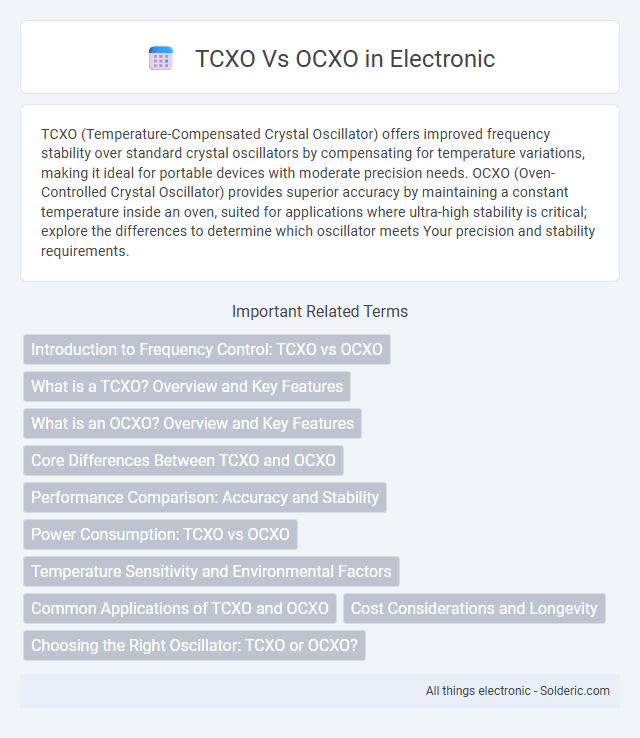TCXO (Temperature-Compensated Crystal Oscillator) offers improved frequency stability over standard crystal oscillators by compensating for temperature variations, making it ideal for portable devices with moderate precision needs. OCXO (Oven-Controlled Crystal Oscillator) provides superior accuracy by maintaining a constant temperature inside an oven, suited for applications where ultra-high stability is critical; explore the differences to determine which oscillator meets Your precision and stability requirements.
Comparison Table
| Feature | TCXO (Temperature Compensated Crystal Oscillator) | OCXO (Oven Controlled Crystal Oscillator) |
|---|---|---|
| Temperature Stability | +-0.1 to +-0.5 ppm | +-0.01 to +-0.05 ppm |
| Operating Temperature Range | -40degC to +85degC | Limited, typically 0degC to 70degC due to oven control |
| Warm-up Time | None (immediate operation) | Several minutes |
| Power Consumption | Low (a few mW) | High (100s of mW to several W) |
| Size | Compact | Larger due to oven enclosure |
| Cost | Low to moderate | High |
| Applications | Mobile devices, GPS, telecom | Precision measurement, broadcast, aerospace |
Introduction to Frequency Control: TCXO vs OCXO
Temperature-Compensated Crystal Oscillators (TCXO) and Oven-Controlled Crystal Oscillators (OCXO) are critical components in frequency control for precise electronic applications. TCXO maintains frequency stability by compensating for temperature variations using electronic circuitry, while OCXO achieves superior stability through a temperature-controlled oven that keeps the crystal at a constant temperature. The choice between TCXO and OCXO depends on the required frequency accuracy, power consumption, and environmental conditions of the application.
What is a TCXO? Overview and Key Features
A Temperature Compensated Crystal Oscillator (TCXO) is a precision timing device designed to maintain stable frequency performance across varying temperatures by using temperature compensation circuitry. Key features include low power consumption, compact size, and enhanced frequency stability compared to standard crystal oscillators, typically achieving stability within +-0.5 to +-2.0 ppm over a wide temperature range. TCXOs are widely used in portable communications, GPS receivers, and other applications requiring reliable frequency stability under thermal fluctuations.
What is an OCXO? Overview and Key Features
An OCXO (Oven Controlled Crystal Oscillator) is a highly stable frequency reference that maintains a constant temperature around its quartz crystal to minimize frequency variations caused by external temperature changes. Key features include superior frequency stability, low phase noise, and excellent aging characteristics, making OCXOs ideal for precision applications such as telecommunications, GPS, and aerospace. You benefit from enhanced signal accuracy and reliability in environments demanding tight frequency control.
Core Differences Between TCXO and OCXO
TCXO (Temperature-Compensated Crystal Oscillator) uses temperature compensation techniques to maintain frequency stability across a varying temperature range, making it energy-efficient and suitable for portable devices. OCXO (Oven-Controlled Crystal Oscillator) maintains frequency stability by housing the crystal in a temperature-controlled oven, ensuring minimal frequency drift in high-precision applications. The core differences lie in power consumption, size, and frequency stability, with OCXO offering superior stability at higher power and cost, while TCXO provides a compact, low-power, and cost-effective solution.
Performance Comparison: Accuracy and Stability
TCXO (Temperature-Compensated Crystal Oscillator) offers moderate accuracy and stability by compensating frequency drift caused by temperature changes, typically achieving stability around +-0.5 to +-2.0 ppm. In contrast, OCXO (Oven-Controlled Crystal Oscillator) maintains superior accuracy and stability by housing the crystal in a temperature-controlled oven, resulting in stability often better than +-0.01 ppm. OCXO's enhanced temperature regulation makes it the preferred choice for applications demanding the highest precision and minimal frequency deviation over time.
Power Consumption: TCXO vs OCXO
TCXO (Temperature-Compensated Crystal Oscillator) consumes significantly less power than OCXO (Oven-Controlled Crystal Oscillator), making TCXO ideal for battery-powered and portable devices. OCXOs require substantial electrical power to maintain a constant oven temperature, resulting in higher overall energy consumption. Your choice between TCXO and OCXO should consider power availability and consumption needs in your specific application.
Temperature Sensitivity and Environmental Factors
TCXO (Temperature-Compensated Crystal Oscillator) offers moderate temperature sensitivity by using electronic compensation to maintain frequency stability within a range of -40degC to +85degC, making it suitable for most commercial applications. OCXO (Oven-Controlled Crystal Oscillator) provides superior frequency stability as it maintains a constant internal temperature, typically around 75degC, which significantly reduces frequency variations caused by environmental temperature fluctuations. Your choice depends on how critical temperature sensitivity and overall environmental stability are for your precision timing or frequency control requirements.
Common Applications of TCXO and OCXO
TCXO (Temperature-Compensated Crystal Oscillator) is commonly used in mobile devices, GPS receivers, and wireless communication equipment due to its balance of accuracy and low power consumption. OCXO (Oven-Controlled Crystal Oscillator) is favored in high-precision applications such as telecommunications infrastructure, aerospace navigation, and scientific instrumentation because of its superior frequency stability under varying environmental conditions. Your choice between TCXO and OCXO should consider the required accuracy and operating environment of your specific application.
Cost Considerations and Longevity
TCXOs generally offer lower cost and energy consumption compared to OCXOs, making them suitable for budget-sensitive applications with moderate precision requirements. OCXOs provide superior frequency stability and longer operational lifespan due to built-in oven control, justifying their higher initial investment in high-performance systems. The extended longevity of OCXOs often results in reduced maintenance and replacement costs over time, balancing upfront expenses in critical timing applications.
Choosing the Right Oscillator: TCXO or OCXO?
Choosing the right oscillator depends on your application's precision and stability requirements; Temperature Compensated Crystal Oscillators (TCXO) offer moderate frequency stability with lower power consumption, making them ideal for portable and battery-powered devices. Oven Controlled Crystal Oscillators (OCXO) provide superior frequency stability by maintaining a constant temperature inside a heated enclosure, which is crucial for high-precision applications like telecommunications and instrumentation. Your choice between TCXO and OCXO should consider factors such as environmental conditions, power availability, and required frequency accuracy.
TCXO vs OCXO Infographic

 solderic.com
solderic.com